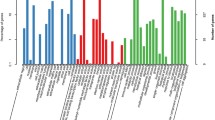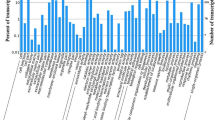Abstract
We have identified and cloned a cDNA encoding the first odorant-binding protein isolated from mosquitoes. The protein isolated from female antennae of Culex quinquefasciatus (CquiOBP) was not detected in legs (control tissue) or in antennal extracts from males, and showed mobility in native polyacrylamide gels similar to that of the pheromone-binding protein from Bombyx mori. The open reading frame of the cloned cDNA encoded a hydrophobic signal peptide (24 residues) and an acid mature protein (pI 5.5) of 125 amino acid residues (calculated molecular mass 14,504 Da). The transcript was detected by RT-PCR with antennal, but not with leg tissues. CquiOPB shared the highest amino acid identity with a product deduced from Drosophila melanogaster PBPRP-3 cDNA (58.6%), OBPs from scarab beetles (35%), and moths (28%). In addition, CquiOBP showed the hallmark of insect odorant-binding proteins, the six Cys residues.
Similar content being viewed by others
REFERENCES
Costantini, C., Birkett, M. A., Gibson, G., Ziesmann, J., Sagnon, N. F., Mohammed, H. A., Coluzzi, M., and Pickett, J. A.2001. Electroantennogram and behavioural responses of the malaria vector Anopheles gambiaeto human-specific sweat components. Med. Vet. Entomol.15:259–266.
Davis, E. E., and Bowen, M. F.1994. Sensory physiological basis for attraction in mosquitoes. J. Am. Mosq. Control Assoc.10:316–325.
Deyu, Z., and Leal, W. S.2002. Conformational isomers of insect odorant-binding proteins. Arch. Biochem. Biophys.397:99–105.
Laurence, B. R., and Pickett, J.A.1982. erythro-6-Acetoxy-5-hexadecanolide, the major component of a mosquito oviposition attractant pheromone. J. Chem. Soc. Chem. Commun.59–60.
Leal, W. S., and Uchida, K.1998. Application of GC-EAD to the determination of mosquito repellents derived from a plant, Cymbopogon citratus. J. Asia-Pacific Entomol.1:217–221.
Michael, E., Bundy, D. A. P., and Grenfell, B. T.1996. Re-assessing the global prevalence and distribution of lymphatic filariasis. Parasitology112:409–428.
Peng, G. H., and Leal, W. S.2001. Identification and cloning of a pheromone-binding protein from the oriental beetle, Exomala orientalis. J. Chem. Ecol.27:2183–2192.
Pikielny, C. W., Hasan, G., Rouyer, F., and Rosbash, M.1994. Members of a family of Drosophilaputative odorant-binding proteins are expressed in different subsets of olfactory hairs. Neuron12:35–49.
Vogt, R. G., Callahan, F. E., Rogers, M. E., and Dickens, J. C.1999. Odorant binding protein diversity and distribution among the insect orders, as indicated by LAP, an OBP-related protein of the true bug Lygus lineolaris(Hemiptera, Heteroptera). Chem. Senses24:481–495.
Wojtasek, N., Picimbon, J. F., and Leal, W. S.1999. Identification and cloning of odorant binding proteins from the scarab beetle Phyllopertha diversa. Biochem. Biophys. Res. Commun.263:832–837.
Author information
Authors and Affiliations
Corresponding author
Rights and permissions
About this article
Cite this article
Ishida, Y., Cornel, A.J. & Leal, W.S. Identification and Cloning of a Female Antenna-Specific Odorant-Binding Protein in the Mosquito Culex quinquefasciatus . J Chem Ecol 28, 867–871 (2002). https://doi.org/10.1023/A:1015253214273
Issue Date:
DOI: https://doi.org/10.1023/A:1015253214273




